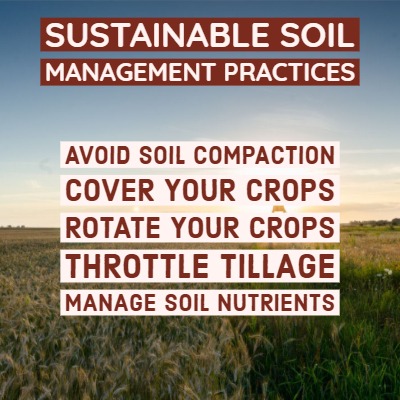How Can I Achieve Sustainable Farm Soil Management?
Whether for economic reasons, social reasons or both, modern farmers are considering a variety of options to increase the sustainability of their operations. One of the biggest factors that influences a farm’s sustainability is how the crew interacts with, cultivates and maintains the soil. Many efforts and agricultural products focus on above-ground farm soil management, but few organizations consider what happens with soil beneath the surface. In this article we discuss what farm soil management is, which practices foster sustainability and which Pro-Soil products can help.
What Is Farm Soil Management?
Farm soil management can be broken down into two main groups: above ground and below ground.
Above ground practices include irrigation, application of fertilizers and tillage.
Below ground practices rely almost exclusively on the micro and macro biomes of the soil and unlocking their potential.
Which Practices Aid in Sustainable Soil Management?
- Avoid Soil Compaction: farmers must look out for which machines are driven over crop land and at what frequency. Heavy movement across crops, even in their early development, can increase soil compaction and reduce soil porosity. Working with wet soil further increases compaction. The rule of thumb we recommend is to let the crop field dry completely prior to fieldwork. You can also fight compaction by dispersing the weight of your farm vehicles across a greater surface area by decreasing the PSI in vehicle tires. Latham Hi-tech Seeds cites a study conducted by Iowa State University on mitigating soil compaction when they say, “[R]esearch shows that using equipment with 6 pounds per square inch (psi) of surface pressure yielded 9 bushels per acre more than equipment with 16 psi.” If compaction is left unchecked, the necessary air, water and nutrients will need to work harder to reach the plants.
- Crop Covering: covering crop fields when not in use can help to reduce soil degradation and soil erosion via weather events.
- Rotation of Crops: It’s important not to overtax the soil by growing the same crops in the same locations every time; alternating crops that produce different residues can also aid in soil conservation.
- Tillage: The decision of when to till and plow, when to not and at what frequencies will influence soil fertility. Some advocate reducing these practices as much as possible to better guard against erosion and to better retain water.
- Soil Nutrient Management: Use of fertilizers and organic matter will influence the nutrients available to crops as they grow. Some products make use of topical application, but very few products use below-ground soil management strategies.
Pro-Soil’s Soil Activator Stimulates Soil Biology
 Pro-Soil produces an outstanding soil activator called PS – Foundation 1-0-1. Soil activation, also known as bio stimulation, is designed to stimulate the microbial activity in farm soil. Harnessing the power of natural biology and preexisting nutrients helps farmers to reduce inputs and increase crop yields.
Pro-Soil produces an outstanding soil activator called PS – Foundation 1-0-1. Soil activation, also known as bio stimulation, is designed to stimulate the microbial activity in farm soil. Harnessing the power of natural biology and preexisting nutrients helps farmers to reduce inputs and increase crop yields.
Below-ground soil management such as our PS – Foundation 1-0-1 can help to mellow the soil, increase root mass and better the nutrient availability.
Pro-Soil achieves soil activation by using materials including organic acids, fertilizers, chelated trace minerals, kelp, enzymes, a compatible non-ionic surfactant and most importantly, humates.
Stimulating the soil’s biology is an outstanding way to turn your farm towards sustainability.
